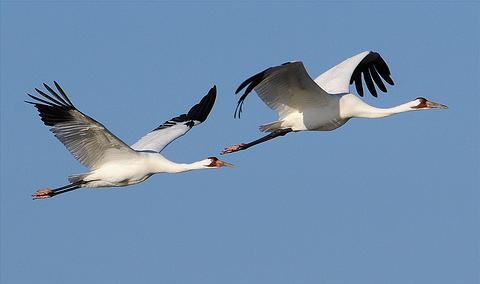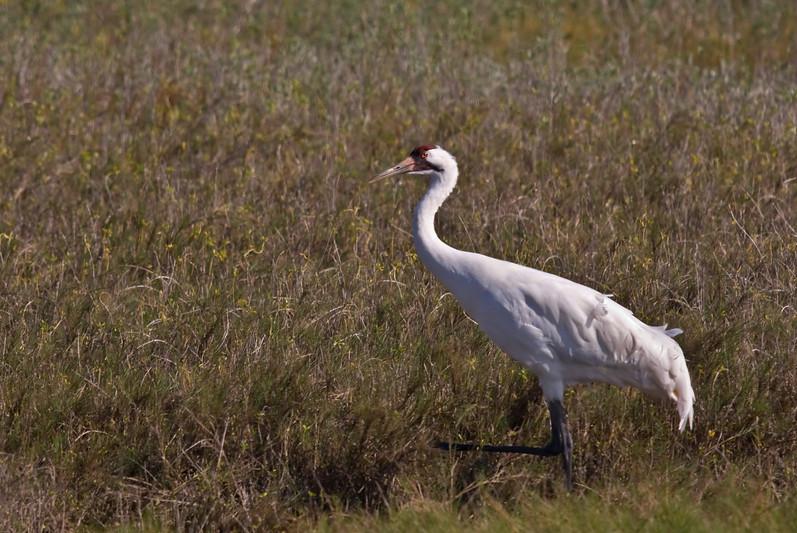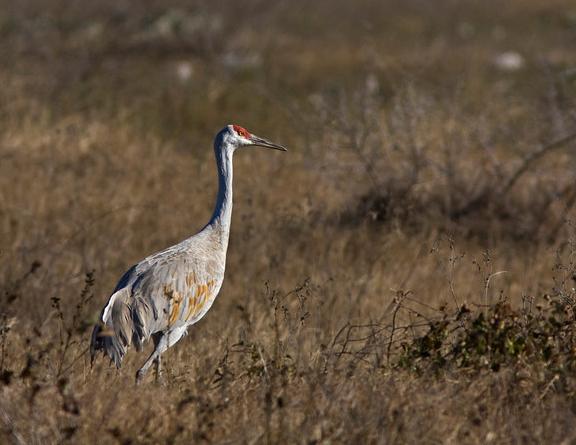
What do whooping cranes look like?
The whooping crane is a very breathtaking bird to see and observe. This bird is just about as tall as me (me being 5'1"), with heights reaching up to five feet! Because of this staggering height, the whooping crane is known as the tallest bird in all of North America. The males are usually bigger than the females, but there is no significant difference between the two sexes. Whooping cranes may weigh anywhere from 14 to 16 pounds, making this bird quite a light weight compared to its height. The often hollow bones that are seen in birds helps the whooping crane keep its weight low.
I will describe the appearance of the adult whooping crane from head to toe, starting with its head. The whooping crane has bare red skin on its head (called a crown) and also on its chin near the beak. This bare red skin is a significant feature of this bird. The beak of the whooping crane is of a yellow/green/gray color combination, while the eyes are a bright yellow. To hear the whooping cranes call (the whole reason it got its name), click here!
The whooping crane is also the only North American crane that
possesses pure white feathers covering the entire body except for
black primaries (the biggest feathers at the edge of
wings). This coloration may, however, cause this organism a disadvantage as it has been seen that completely white
cranes all over the world suffer from population risks and losses,
while cranes of different colors don't see as much of a problem.
The black primaries do not show unless in flight (with a wing span
of almost eight feet in length) where their posture is with a
long, out-stretched neck and fully extended legs. Along with
the primary feathers, the whooping crane also has black legs.
organism a disadvantage as it has been seen that completely white
cranes all over the world suffer from population risks and losses,
while cranes of different colors don't see as much of a problem.
The black primaries do not show unless in flight (with a wing span
of almost eight feet in length) where their posture is with a
long, out-stretched neck and fully extended legs. Along with
the primary feathers, the whooping crane also has black legs.
There are a few species that you may mistake for a whooping crane including: the sandhill crane, the American white pelican, the snow goose, and some egrets and herons. To tell the difference between the closely related whooping and sandhill cranes, sandhill cranes are a gray and rust color and have gray primaries. Both cranes do, however, possess red on the crown. The American white pelican has similar coloration of the whooping crane, but has black along the entire length of the wing (not just in the primaries) and their legs don't extend in flight because of their short length. If you'd like to learn more about the American white pelican and also see pictures, click here! Snow geese are smaller yet, have similar coloration, but do not have a long bill or longs legs that extend during flight. Last but not least, herons and egrets are often white, but are also smaller than the whooping cranes tall stature, have completely white wings and fly with their necks folded in, not extended.
If you want to learn more about what juvenile whooping cranes look like and also see some pictures, visit my Life History page here. A good step from this page is to learn how the whooping crane is classified, in which you can access my Classification page here. If you want to start over, you can click here to reach my homepage.


